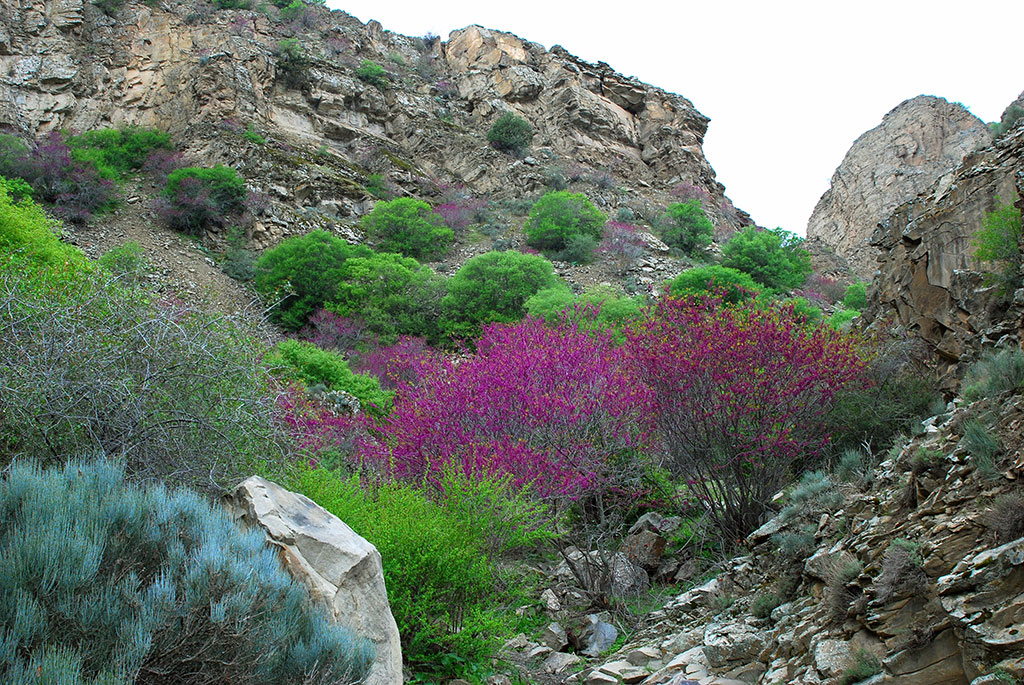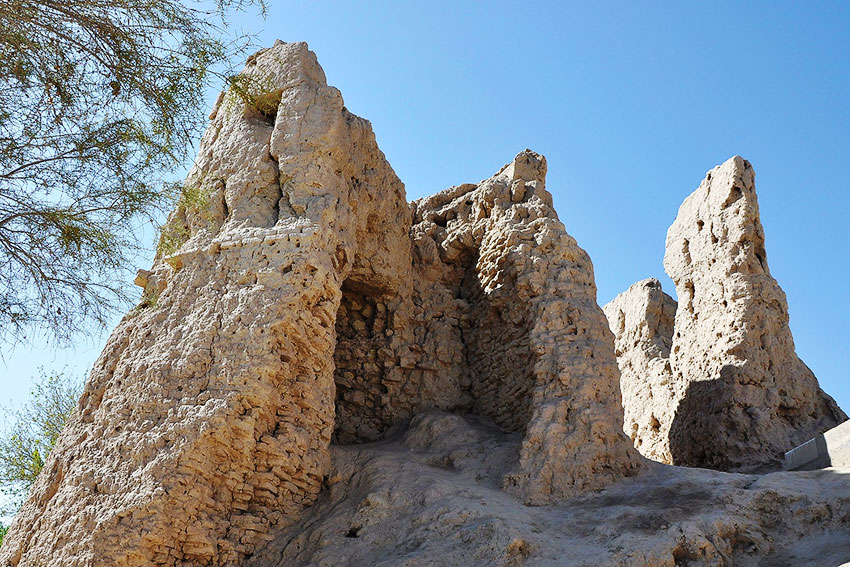In the remote past, the waters of ancient Tetis Sea swashed on the vast spaces from North Africa till Black Sea. Centuries have passed before receding of the sea, and constant Earth crust movement led to formation of relief of Kopetdag mountain range, having granted it with dense strata of limestone, clayey-limestone sandstones, light grey marls and other rocks.

If Tien Shan is called the mountains in steppe, then Kopetdag – the mountains of desert. On the foothill plain, the mercury column of thermometer in summer can exceed the limit of forty degrees above zero, and on the mountains at the height of over two thousand meters in winter, it can fall up to thirty degrees below zero. In winter, snow covers the mountains with white shawl from peak to foot. Sometimes, it is kept till the end of not hot spring. Kopetdag replenishes its stock of moisture owing to spring rains.
Nature granted Kopetdag Mountains with rivulets and springs, where life is always in full swing particularly in sultry period, as well as with fertile soil – sierozems, having supplemented them with meadow lands along valleys of mountain rivulets. Here, in the line of late chalk and palaeogene or nearly 12 million years ago, it was arisen the vegetation of Kopetdag, which separate representatives reached our days as relicts.

So, on small- crushed stone substratum in outskirts of Guryhowdan settlement, it is possible to see in spring the yellow- lilac flowers of senna, in the vicinities of Shamli settlement - radical crowns of leaves of the Turkmen lemon, near Kurtusu village – lilac flowers of Kopetdag stonecress, which inhabitation has not found anywhere else in the world.
Over thousands varieties of plants grow in different soil and climatic conditions of mountain terrain at various heights. Most spread types among them are the species of Compositae family, cereals and legumes. At that, herbaceous plants in Kopetdag are much than bushes and trees.

Distinctive peculiarity of local flora is the high percent of endemism (up to 20%). Any other mountainous Central Asian flora can envy it. Prickliness of many species, reaching at times to grotesque, is striking. This dry rocky and thorny mountain desert is quite comfortable for plants, which differ by extreme level of drought-resistance. They were capable to turn the leave, branch and leafstalk into thorn.
Kopetdag is the land of contrasts, because among thawing snowfields, it is possible to meet the blue splendor of fragrant flowers of wild hyacinth, lavender crocus and whitish-pink of flower of colchicum, blue- violet and pink sword-grass lily with leaves resemble to the edge of knife, pale yellow and white iris and hazel grouse. Real beauty and wealth in the bunch of flowers is tulips with tender white, pink-pale, crimson-red and bright-red flowers.

Main plant of the mountains is the Turkmen juniper or conifer - long-liver, which according to its ecological significance, cannot be replaced with any other specie of local flora. What is the reason of this high value? It is not easy to answer. Juniper is the principal kernel in formation of all mountain vegetable groups. This tree grows 600 and more years. The dry wormwood “steppes” devoid of the riot of spring miscellaneous herbs, most of which medicinal species or wild varieties of cultivated plants, dominate in the zones, where no juniper. Roots of juniper hold soil and composition of mountain slopes within centuries, gathering reviving water from precipitations, creating conditions for growth and development of a bulk of local flora.

The flora of Kopetdag includes wild fruit trees - cherry plum, apple tree, mountain ash, pear tree, quince tree, blackberry bush, hawthorn, and grape. They form along the bottom of valleys the lines of natural forest-gardens. At that, in subtropical Southwest Kopetdag, such floristic “fragments” are rather much than in the Central. Ancient relicts of more moist periods are eastern plane, English walnut and wild pomegranate. Ancestral species of the Turkmen apple tree were cultivated here in V-IV centuries B.C. since time of Parthian empire. It is interesting that most of ancient local grape sorts are the offsets of the Parthian plant sorts, which in turn, were originated from wild grape found today as well. Botanists note that local varieties of fig were the wild ones, cultivated further by population.

Deciduous xerophyte “woods” from maple, almond and bean caper are wide spread along dry slopes of Kopetdag. They form rather large massifs, which often grow on savanna type. Fragmentary distribution also has cercis, hawthorns, cotoneasters and pistachio, which are of great significance as gene pool. Riparian woodlands from elm, poplar, willow and ash, which were common to these places since eneolite, are also of particular value. Today, they are living witnesses of the past epochs.

Particular spice of the vegetable cover of Kopetdag is its mountain feather grassy and fescue steppes, which rise high above forest juniper communities.
Plant associations of Kopetdag, being diverse in species composition and conditions of growth, are particular priceless natural resource of our country and national property.

If Tien Shan is called the mountains in steppe, then Kopetdag – the mountains of desert. On the foothill plain, the mercury column of thermometer in summer can exceed the limit of forty degrees above zero, and on the mountains at the height of over two thousand meters in winter, it can fall up to thirty degrees below zero. In winter, snow covers the mountains with white shawl from peak to foot. Sometimes, it is kept till the end of not hot spring. Kopetdag replenishes its stock of moisture owing to spring rains.
Nature granted Kopetdag Mountains with rivulets and springs, where life is always in full swing particularly in sultry period, as well as with fertile soil – sierozems, having supplemented them with meadow lands along valleys of mountain rivulets. Here, in the line of late chalk and palaeogene or nearly 12 million years ago, it was arisen the vegetation of Kopetdag, which separate representatives reached our days as relicts.

So, on small- crushed stone substratum in outskirts of Guryhowdan settlement, it is possible to see in spring the yellow- lilac flowers of senna, in the vicinities of Shamli settlement - radical crowns of leaves of the Turkmen lemon, near Kurtusu village – lilac flowers of Kopetdag stonecress, which inhabitation has not found anywhere else in the world.
Over thousands varieties of plants grow in different soil and climatic conditions of mountain terrain at various heights. Most spread types among them are the species of Compositae family, cereals and legumes. At that, herbaceous plants in Kopetdag are much than bushes and trees.

Distinctive peculiarity of local flora is the high percent of endemism (up to 20%). Any other mountainous Central Asian flora can envy it. Prickliness of many species, reaching at times to grotesque, is striking. This dry rocky and thorny mountain desert is quite comfortable for plants, which differ by extreme level of drought-resistance. They were capable to turn the leave, branch and leafstalk into thorn.
Kopetdag is the land of contrasts, because among thawing snowfields, it is possible to meet the blue splendor of fragrant flowers of wild hyacinth, lavender crocus and whitish-pink of flower of colchicum, blue- violet and pink sword-grass lily with leaves resemble to the edge of knife, pale yellow and white iris and hazel grouse. Real beauty and wealth in the bunch of flowers is tulips with tender white, pink-pale, crimson-red and bright-red flowers.

Main plant of the mountains is the Turkmen juniper or conifer - long-liver, which according to its ecological significance, cannot be replaced with any other specie of local flora. What is the reason of this high value? It is not easy to answer. Juniper is the principal kernel in formation of all mountain vegetable groups. This tree grows 600 and more years. The dry wormwood “steppes” devoid of the riot of spring miscellaneous herbs, most of which medicinal species or wild varieties of cultivated plants, dominate in the zones, where no juniper. Roots of juniper hold soil and composition of mountain slopes within centuries, gathering reviving water from precipitations, creating conditions for growth and development of a bulk of local flora.

The flora of Kopetdag includes wild fruit trees - cherry plum, apple tree, mountain ash, pear tree, quince tree, blackberry bush, hawthorn, and grape. They form along the bottom of valleys the lines of natural forest-gardens. At that, in subtropical Southwest Kopetdag, such floristic “fragments” are rather much than in the Central. Ancient relicts of more moist periods are eastern plane, English walnut and wild pomegranate. Ancestral species of the Turkmen apple tree were cultivated here in V-IV centuries B.C. since time of Parthian empire. It is interesting that most of ancient local grape sorts are the offsets of the Parthian plant sorts, which in turn, were originated from wild grape found today as well. Botanists note that local varieties of fig were the wild ones, cultivated further by population.

Deciduous xerophyte “woods” from maple, almond and bean caper are wide spread along dry slopes of Kopetdag. They form rather large massifs, which often grow on savanna type. Fragmentary distribution also has cercis, hawthorns, cotoneasters and pistachio, which are of great significance as gene pool. Riparian woodlands from elm, poplar, willow and ash, which were common to these places since eneolite, are also of particular value. Today, they are living witnesses of the past epochs.

Particular spice of the vegetable cover of Kopetdag is its mountain feather grassy and fescue steppes, which rise high above forest juniper communities.
Plant associations of Kopetdag, being diverse in species composition and conditions of growth, are particular priceless natural resource of our country and national property.






